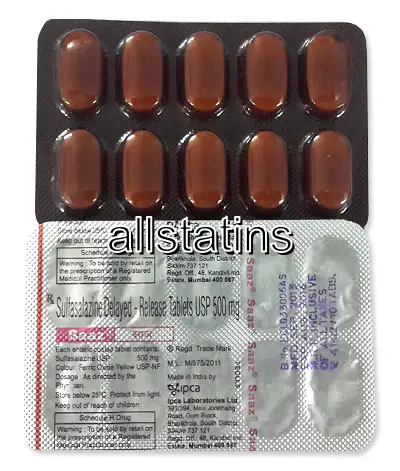| Package | Dosage | Price | Price per Dose | |
|---|---|---|---|---|
| Dosage: 500mg | ||||
| 360 pill | 500mg | $690.67 | $1.92 | |
| 270 pill | 500mg | $538.18 | $1.99 | |
| 180 pill | 500mg | $394.66 | $2.19 | |
| 120 pill | 500mg | $288.82 | $2.40 | |
| 90 pill | 500mg | $231.41 | $2.57 | |
| 60 pill | 500mg | $170.41 | $2.85 | |
| 30 pill | 500mg | $105.83 | $3.50 | |

Azulfidine Description
Understanding Azulfidine (Sulfasalazine)
Azulfidine, known generically as sulfasalazine, is a widely prescribed medication in the United States for treating inflammatory conditions of the gastrointestinal tract. It is primarily used to manage ulcerative colitis and Crohn’s disease, helping to reduce inflammation and control symptoms. This medication combines a sulfonamide antibiotic with a salicylate, which work together to decrease inflammation and suppress the immune response. Patients often appreciate it for its effectiveness in managing flare-ups and maintaining remission.
How Does Azulfidine Work?
Azulfidine works locally in the colon and rectum, where it releases active compounds that reduce inflammation. The medication targets the inflamed tissues, decreasing swelling, redness, and pain associated with inflammatory bowel diseases. Some patients find that Azulfidine not only alleviates symptoms like diarrhea and abdominal pain but also helps prevent disease progression. Its ability to be administered orally makes it convenient for long-term use, fitting well into daily routines.
Potential Benefits and Efficacy
Patients using Azulfidine often report noticeable improvements within a few weeks of starting treatment. It is considered effective at inducing and maintaining remission in ulcerative colitis cases. Moreover, some individuals with Crohn’s disease find it beneficial for less severe cases. In the USA, Azulfidine is recognized as a reliable option due to its long-standing history and extensive research backing its safety profile. The medication can reduce the frequency and severity of flare-ups, which significantly enhances the quality of life for many patients.
Possible Side Effects and Considerations
Like all medications, Azulfidine carries potential side effects. Common reactions include nausea, loss of appetite, headaches, and skin rashes. In some cases, patients might experience more serious effects such as low blood cell counts or liver issues, though these are rare. It's important for users to have regular blood tests while on this medication to monitor their health. Individuals allergic to sulfa drugs should avoid Azulfidine due to the risk of allergic reactions. Patients are advised to inform their healthcare provider about any other medications they are taking to prevent interactions.
What to Know Before Starting Azulfidine
Prior to beginning treatment with Azulfidine, users in the USA should discuss their complete health history with their doctor. Pregnancy and breastfeeding considerations are important; while some women may use Azulfidine under medical supervision, others should avoid it due to potential risks. People with kidney or liver problems, blood disorders, or certain allergies should approach this medication cautiously. As part of good health management, routine blood work and monitoring are recommended to ensure the medication's safety.
Availability and Usage in the USA
In the United States, Azulfidine is available by prescription through licensed pharmacies. It comes in various tablet strengths, allowing doctors to tailor dosages based on the severity of the condition and individual response. Patients are encouraged to follow their healthcare provider’s instructions precisely, including dosage timing and frequency. Proper adherence helps maximize the medication's effectiveness and minimizes the risk of side effects. Many users find Azulfidine to be a vital part of their treatment plan, helping them live more comfortable and active lives despite their chronic condition.